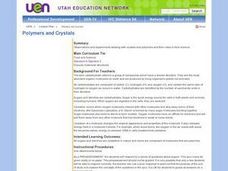Curated OER
The Four Groups of Biologically Important Compounds
This is not they typical set of teacher instructions. It is an organized chart of the important organic compounds. For each, the involved elements, the name of the building block monomers, the names of polymers, extra information, and a...
Curated OER
Review of Ionic and Covalent Compounds and Transitioning from Ionic to Covalent Compounds
Here is a unique assigment: compare and contrast ionic and covalent compounds in an extensive data table and then analyze Lewis dot structures in antoher. Three columns are to befilled in: "characteristic or feature," "applies to ionic...
Curated OER
Who Took Jerell's iPod? ~ An Organic Compound Mystery
Within the setting of a crime scene investigation, biochemistry beginners analyze organic compounds as a means of determining "Who dunnit." They use a brown paper test for lipids, glucose test strips and iodine to identify carbohydrates,...
Curated OER
Nucleic Acids
A lively presentation presents general facts and history of nucleic acids in a note-taking format. Every slide contains colorful photos or graphics to illuminate and engage. Biology aces learn about the function and structure of these...
Curated OER
Macromolecules
Magnify macromolecules for your biology class by having them answer these ten questions. They will define monomers and polymers, list monosaccharides, and analyze polysaccharides. In addition to assigning this to your biology class, you...
Curated OER
Carbohydrates: Disaccharides & Polysaccharides
Feed your young chemists a carbohydrate feast with this presentation. Partakers will ingest molecules of maltose, lactose, sucrose, cellulose, and more! This concise lesson introduces viewers to the molecular structure of different...
Curated OER
Organic Molecules
Introduce viewers to the organic compounds with this presentation. It does not contain much information; it is mostly comprised of bullet points for each topic: monomers, polymers, carbohydrates, lipids, proteins, and nucleic acids. No...
Curated OER
Nutrition: How Much Fat Am I Eating?
How much fat is in this? Scholars first read some background information on the caloric content of fats versus carbohydrates, and then use that knowledge to analyze foods they regularly eat. They will look at 5 package labels for the...
Curated OER
Organic Compounds
For this organic compounds worksheet, learners practice identifying chemical structures and compare sugars, starches, and lipids. This worksheet has 5 matching and 15 multiple choice questions.
Curated OER
Determination of the Physical Properties of Dietary Fibers
In this dietary fibers worksheet, students compare and contrast the properties of different fibers: cellulose, hemicellulose, pectin, guar, agar, and xanthan gum. This worksheet has 5 short answer questions.
Curated OER
What's Happening to Your Body
Students list the types of biological development that occur during adolescence and the nutritional, physical, and mental needs that support that development. They describe careers in the field of adolescent health.
Curated OER
Polymers and Crystals
Learners experiment with crystals and polymers and examine their roles in food science.
University of Illinois
University of Illinois: The Photosynthetic Process
Site describes process of photosynthesis, including role of pigment molecules, electron transport, ATP synthesis, and carbohydrate synthesis. Includes links to illustrative graphics.
Other
British Nutrition Foundation: Food a Fact of Life (11 14): Energy and Nutrients
Students learn about the energy and nutrient requirements of humans in this comprehensive tutorial. They will look at dietary sources of energy, what the human body needs, changes in those needs during life's stages, the energy required...
The Association of the British Pharmaceutical Industry
Abpi: Digestion
A student-paced tutorial where learners read information, answer interactive review activities, and then take a self-checking quiz at the end of the lesson.
Chem4kids
Chem4 Kids: Sweet Sweet Carbs
Here you can learn all about carbohydrates! Content explores what carbohydrates are used for in the body, as well as the different types: saccharides, regular sugars, and polysaccharides.
Concord Consortium
Concord Consortium: Stem Resources: The Tree of Life's Molecules
An interactive activity where you can zoom in to explore the macromolecules present in organisms. Learn about proteins, carbohydrates, lipids, and nucleic acid as you investigate the molecular structure of these types of macromolecules....
Science Education Resource Center at Carleton College
Serc: Investigating Starch in Foods
This lesson would be used during our nutrition unit when discussing carbohydrates. In this classroom activity students investigate which foods have starch in them by using iodine, as well as investigate the result of iodine and lemon...
Estrella Mountain Community College
Online Biology Book: Chemistry Ii: Water and Organic Molecules
Online biology textbook discussing the chemical nature of water, and the importance of its molecular structure to life. Also discusses at length the organic molecules nucleic acids, proteins, lipids, and carbohydrates.
Ohio State University
Ohio State University: Lipids and Carbohydrates
An introduction to these chemical families. Diagrams are easy to understand and the text explains basic concepts well.
Other
Web Health Centre: Food at Work
Read about the roles of protein, carbohydrates, fats, vitamins, and minerals. Learn what kinds of foods are "Body builders," "Energy givers," and "Protectors," and tailor your diet so that you are getting the nutrients you need to...
Sophia Learning
Sophia: Disaccharides: Lesson 2
This lesson will introduce disaccharides, including an overview of their structure, and providing multiple examples. It is 2 of 4 in the series titled "Disaccharides."
Sophia Learning
Sophia: Introduction to Carbohydrates: Lesson 2
This lesson will introduce the basic structure and function of a carbohydrate. It is 2 of 3 in the series titled "Introduction to Carbohydrates."
Sophia Learning
Sophia: Polysaccharides: Lesson 2
This lesson will introduce polysaccharides, including an overview of their structure, and providing multiple examples. It is 2 of 3 in the series titled "Polysaccharides."























